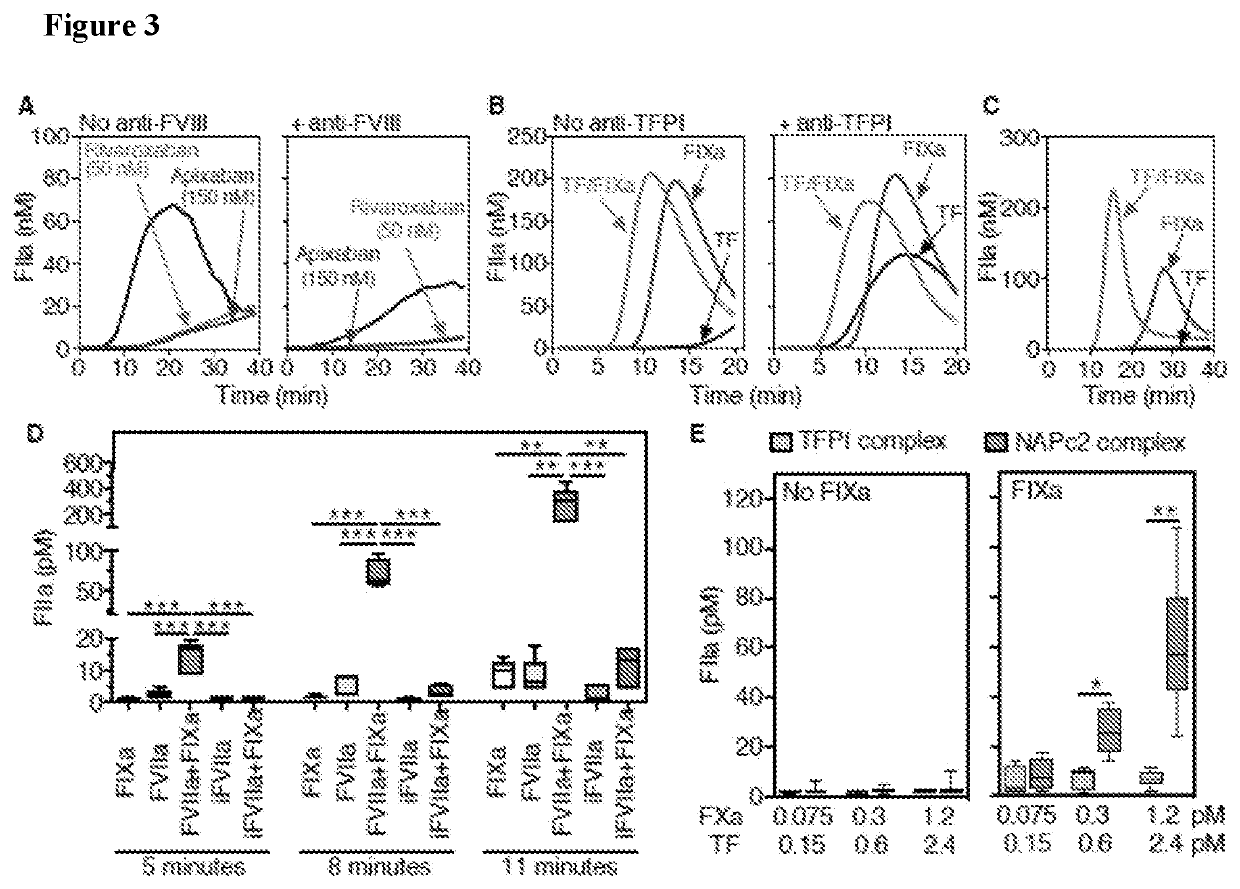Compositions and methods for thrombin generation assay
a thrombin generation and composition technology, applied in the field of medical and biomedical science, can solve problems that current knowledge cannot explain, and achieve the effects of high sensitive and rapid assay, predict the risk of hemorrhage and thrombogenesis, and high sensitiv
- Summary
- Abstract
- Description
- Claims
- Application Information
AI Technical Summary
Benefits of technology
Problems solved by technology
Method used
Image
Examples
example 1
Both TF and CP Coagulation Pathways Contribute to FeCl3-Induced Thrombosis
[0094]In the conventional view of the coagulation cascade, illustrated in FIG. 1, the extrinsic TF pathway generates limited amounts of thrombin promoting feedback reactions in which the soluble plasma procofactors, FVIII and FV, are activated along with FXI. Activated FXI (FXIa) in turn cleaves FIX to FIXa, which can also be generated by TF-FVIIa. FIXa then amplifies procoagulant protease production through intrinsic tenase (FVIIIa-FIXa) and prothrombinase (FVa-FXa) complexes. This paradigm explains why FVIIa, and not FXII, is pro-hemostatic, as is removal of TFPI control in FVIII deficiency. However, this current paradigm cannot explain why polyanion-dependent FXIIa-mediated activation of FXI is essential in TF-initiated experimental arterial thrombosis.
[0095]In various embodiments, the present disclosure addresses this problem. In one embodiment, the disclosure herein confirms through various experiments an...
example 2
Coagulation Protease Generation in Reactions with Purified Components
[0096]In some embodiments, coagulation protease generation in reactions with purified components was determined. In one embodiment, consistent with results in plasma, rTF produced only minimal FXa and thrombin (FIIa), but in combination with FIXa yielded more than additive amounts of each protease. In some embodiments, the activation of FVIII and FV preceded the burst of thrombin activity and, unexpectedly, was by far more efficient in the presence of rTF than FIXa alone. In various embodiments, these results suggested the possibility that the extrinsic coagulation initiation complex acted as a direct activator of plasma-derived coagulation cofactors prior to significant thrombin generation. In agreement with this concept, rTF caused dose-dependent cofactor activation in the presence of FVIIa and FX in a simplified prothrombin-free system with added lepirudin to inhibit potential trace contamination by thrombin. In...
example 3
FVIIIa Generation by the TF Pathway Initiation Complex
[0098]In some embodiments, FVIIIa generation by the TF pathway initiation complex is a key step in the alternative coagulation paradigm disclosed here. In some embodiments, this concept was verified in reactions concurrently initiated by TF and FXIIa. It was found that pre-activated FVIIIa, but not pro-cofactor FVIII, bypassed the rTF-FVIIa effect on FXa generation after coagulation initiation by FXIIa or FXIa. Moreover, in a mouse model in which concurrent administration of sub-threshold concentrations of anti-TF and anti-FXI MoAbs prevented FeCl3-induced femoral vein thrombosis, infusing FVIIIa—but not FVIII—restored occlusion by a fibrin-rich thrombus. In some embodiments, FVIIIa failed to reverse the antithrombotic effect of a higher, fully inhibitory anti-FXI MoAb dose, establishing that FVIIIa acted only in the CP-dependent synergistic coagulation pathway as disclosed herein. In some embodiments, these findings support the ...
PUM
| Property | Measurement | Unit |
|---|---|---|
| TG | aaaaa | aaaaa |
| concentrations | aaaaa | aaaaa |
| concentrations | aaaaa | aaaaa |
Abstract
Description
Claims
Application Information
 Login to view more
Login to view more - R&D Engineer
- R&D Manager
- IP Professional
- Industry Leading Data Capabilities
- Powerful AI technology
- Patent DNA Extraction
Browse by: Latest US Patents, China's latest patents, Technical Efficacy Thesaurus, Application Domain, Technology Topic.
© 2024 PatSnap. All rights reserved.Legal|Privacy policy|Modern Slavery Act Transparency Statement|Sitemap



